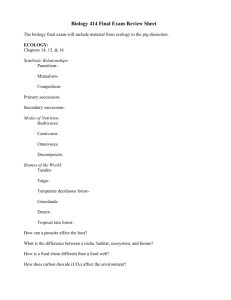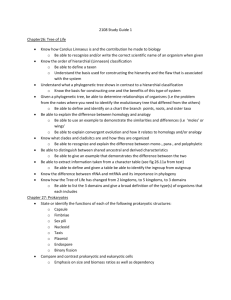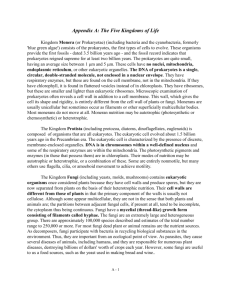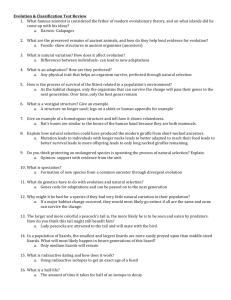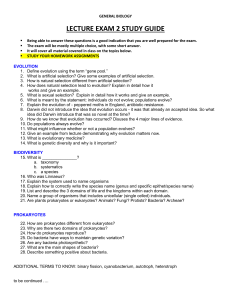Biology Lab Practical Review Biology 1110 Instructor: Kate Blinka 1
advertisement
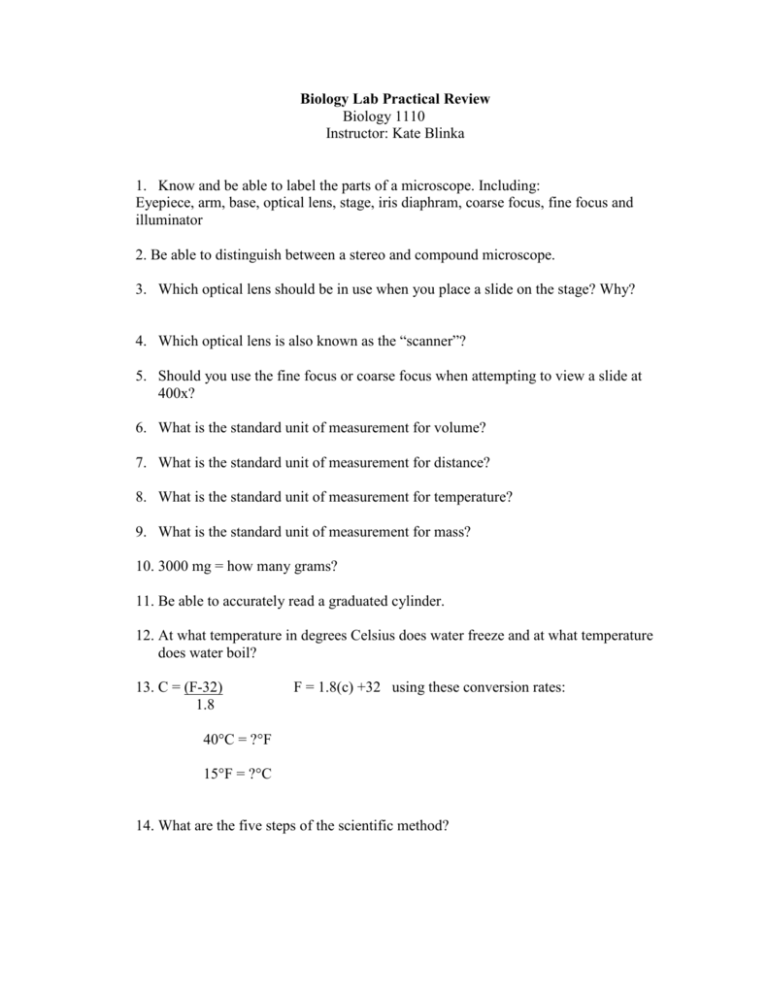
Biology Lab Practical Review Biology 1110 Instructor: Kate Blinka 1. Know and be able to label the parts of a microscope. Including: Eyepiece, arm, base, optical lens, stage, iris diaphram, coarse focus, fine focus and illuminator 2. Be able to distinguish between a stereo and compound microscope. 3. Which optical lens should be in use when you place a slide on the stage? Why? 4. Which optical lens is also known as the “scanner”? 5. Should you use the fine focus or coarse focus when attempting to view a slide at 400x? 6. What is the standard unit of measurement for volume? 7. What is the standard unit of measurement for distance? 8. What is the standard unit of measurement for temperature? 9. What is the standard unit of measurement for mass? 10. 3000 mg = how many grams? 11. Be able to accurately read a graduated cylinder. 12. At what temperature in degrees Celsius does water freeze and at what temperature does water boil? 13. C = (F-32) 1.8 F = 1.8(c) +32 using these conversion rates: 40°C = ?°F 15°F = ?°C 14. What are the five steps of the scientific method? 15. What information do you cover when writing or describing your results? How does this differ from the information you cover when writing your discussion? 16. Be able to read a short story and recognize/describe each step of the scientific method. 17. What are the 3 subatomic particles that make up an atom? 18. What is the charge of each subatomic particle? 19. Which particles make up the nucleus of an atom? 20. Which particle is involved in bonding? 21. What four elements make up 95% of the human body and are the most common in organic compounds? What are their symbols? What are their atomic numbers? 22. Draw the atomic structure (using rings and dots) for the four elements from question 20. 23. How many electrons are in the outer shell for each of the four common elements of organic compounds? 24. Why is carbon such an important component of organic compounds? (What makes carbon special?) 25. Be prepared to recognize a three-dimensional model of molecules we constructed in class. A list of chemical formulas will be provided, but you must be able to recognize the structure with the formula alone. (you will NOT be given the chemical structure) 26. What is the difference between ionic and covalent bonding? 27. How many double bonds can a carbon atom form? 28. Be able to recognize isomers based on atomic formula and atomic structures. 29. What is a monomer? (hint: for numbers 29 - 32 use the table/chart we filled out in class during the molecular biology lab – lab #3) 30. What are the molecular components of a protein? (what elements make up a protein molecule) 31. What are the molecular components of carbohydrates? 32. What are the molecular components of lipids? 33. What are the steps of the cell cycle? 34. What are the two stages of cell division? 35. What is the difference between mitosis and cytokenesis? 36. What are the stages of mitosis? 37. What do centromeres do? 38. What is the function of centrioles? 39. Do plant cells or animal cells develop a cleavage furrow? A cell plate? 40. What is the shortest stage of mitosis? 41. Be able to recognize the steps of cell division in diagrams, slides, and model forms. 42. What is the “point of no return”? 43. What does DNA look like and where is it found in the nucleus? What information does it contain? 44. What is passive transport? 45. What type of passive transport involves the movement of solute down a concentration gradient? 46. What type of passive transport involved the movement of water down the concentration gradient? Look at the images below. Which solution(s) are hypertonic, hypotonic, and/or isotonic? Did osmosis or diffusion occur in the 1st sample (tube)? Concentration A = 0.3 g/ml Concentration B = 0.3 g/ml A = 0.5 g/ml B = 0.2 g/ml A = 0.01 g/ml B = 0.7 g/ml 47. Be able to recognize a diagram showing facilitated diffusion. 48. What is the formula for photosynthesis? 49. Where to plants get the components necessary to carry out photosynthesis? 50. What is the function of stomata? 51. Where on the plant are stomata found? 52. What is the purpose of guard cells? 53. What, specifically, causes guard cells to open and close? 54. Be able to recognize a guard cell in an image or on a microscope. 55. What three gases may be exchanged through a stomate? 56. Do plants in arid regions tend to have a larger or smaller number of stomata? Why? 57. What are the primary organelles found in a typical animal or plant cell? 58. What organelles are found only in animal cells? 59. What organelles are found only in plant cells? 60. Be prepared to label the organelles of a plant cell or animal cell looking at a slide, diagram, or model. 61. What is the function of the mitochondria, chloroplast, nucleus, ribosome, cell wall, cell membrane, golgi apparatus (body), endoplasmic reticulum (smooth and rough), chromatin, nucleous, vacuole, and the lysosome. 62. Know the primary parts of a chloroplast – the stroma, grana, and thylakoids. Be prepared to label a diagram or model. 63. Be able to locate, identify and tell the function of the following organs/components of the digestive system. These may be on a diagram, a dissected pig, or a model. Organs/Components: mouth, teeth, tongue, esophagus, epiglottis, stomach, duodenum, small intestine, cecum, large intestine, colon, rectum, anus, liver, gall bladder, appendix, and pancreas. 64. What digestive enzyme is produced by the liver and stored in the gall bladder? 65. What are the four primary functions of the liver, as related to digestion? What are villi and micro villi and what purpose do they serve? Where are they found? 66. What are the components of pancreatic juice, what do they digest, and where do they enter the digestive system? (stomach, duodenum, cecum, etc). 67. What domains include prokaryotes? 68. What are the differences between prokaryotes and eukaryotes? 69. Are bacteria prokaryotes or eukaryotes? 70. How many chromosomes to bacteria have? 71. What process to prokaryotes undergo for reproduction? What are the steps of this process? 72. Can genetic information be exchanged between prokaryotes? If so, how? (know the names as well as the descriptions of any exchanges of DNA). 73. How do most genetic changes occur in prokaryotes? 74. Why is there a risk of bacteria becoming resistant to antibiotics? What causes the risk, and why should individuals be concerned? 75. What are the cell shapes of prokaryotes and what do these shapes look like? Be able to identify the shape of a bacteria cell in a diagram or on a slide. 76. What is gram staining and what is it used for? 77. What domain/kingdom of prokaryotes are “extremeophiles” and are known for living in hot springs, swamps, marshes, animal intestines, and water with a high concentration of salt? 78. Know how the label the diagram below. Be prepared to identify structures in a diagram, on a slide, or on a model. What type of organism is shown below? (What kingdom does it belong to and how do you know?) 79. What are the 3 primary divisions of the protists? 80. Which protists carry out photosynthesis? 81. Algae belong in what kingdom? 82. Which type of algae is believed to have given rise to the first plants? 83. What kingdom is Volvox a member of? Is Volvox colonial? How does Volvox move that makes it a little bit unusual? 84. What is the organism shown below? What kingdom does it belong to? Is it animal like or plant like? Know the labels shown on THIS diagram. Be able to label a blank diagram. 85. What is conjugation? Be able to recognize a Spirogyra conjugating. 86. What is the organism shown below? Be able to label all structures shown on a slide, diagram, or model. 87. What kingdom do amoebas belong to? What process is shown below? What organism is carrying out the process? 88. Are any protists parasitic to man? 89. Are amoebas ever parasitic? 90. Be able to recognize an amoeba, kelp, and paramecium. 91. Be able to label kelp as shown in the diagram. 92. What kingdom is comprised of organisms that digest their food outside their bodies? 93. How do fungi differ from protists and plants? 94. Are fungi more closely related to plants or animals? 95. What are the main steps in fungal SEXUAL reproduction? 96. What are the steps in fungal ASEXUAL reproduction? 97. What is a fruiting body? 98. Know the parts shown in the diagram below. Be prepared to label them from a diagram, specimen, or model. What fungi class is the illustrated organism a member of? 99. What class of fungi includes the black bread mold Rhizopus? 100. What types of hyphae are associated with Rhizopus? 100. What class of fungi includes Peziz and Morchella? 101. Are slime molds members of the Fungi kingdom? 102. Be able to recognize Penicillium. What kingdom is it a member of? What class fungus is it? 103. Be able to recognize a stink horn, bracket, and mushroom. Know their class and kingdom. Look carefully through your notes. Know all diagrams provided for you and be prepared to identify any organisms or models you have been shown in class. Exam questions are not limited by this review!
